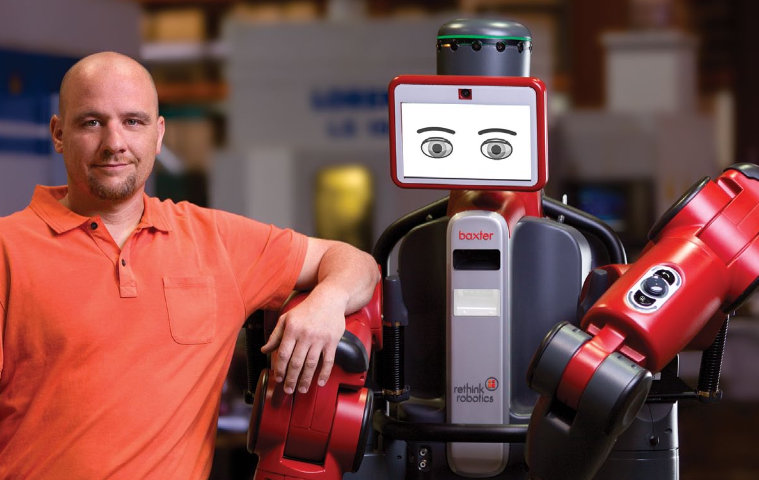Will Robots Create New Jobs When They Take Over Existing Ones?
A new class of industrial robot is appearing. These robots are smart, affordable, and safe enough to work alongside humans, and they can do many tasks that human workers perform today (see “This Robot Could Transform Manufacturing”). But does that necessarily mean there will be fewer jobs left for humans to do?

At a robotics industry event organized by business blog Xconomy in Menlo Park last week, people working on better industrial robots claimed their technology will actually boost the U.S. economy and create more jobs, even if some jobs do disappear forever.
“We’re replacing jobs that people don’t want to do and really shouldn’t be doing,” said Aldo Zini, whose company Aethon makes wheeled robots that ferry medicines, food trays, and garbage around hospital corridors so people don’t have to. Human workers who do those jobs often develop repetitive-stress or back injuries and frequently quit, said Zini. In some cases, better robots will simply be tools for existing workers, not replacements, added Aaron Edsinger, CTO of Redwood Robotics, a company working on making robotic arms cheaper. “We think of it as industrial augmentation to make workers more efficient,” he said. “I think we’ll find new jobs that come from that.”
Edsinger and other robot boosters point back to previous technological revolutions to make the case that even if robots displace some workers, the overall effect on the economy and workforce will be positive. A hundred or so years ago, approximately 70 percent of U.S. workers were engaged in agriculture; the figure today is just 2 percent, Edsinger pointed out. “The tractor [was] one of the great technological disruptions,” he said. “I would be happy if we were building the John Deere of robotics in that we were disrupting how things are made but also enabling the workforce to develop in a different direction.”
Such analogies feel reasonable, but it can be surprisingly difficult to prove that what seem like indisputable leaps forward did indeed advance the lot of workers. Robot entrepreneur Rodney Brooks, founder of iRobot and now Rethink Robotics, whose impressive Baxter robot can work alongside humans, likes to say that a new workforce of robots like his will reinvent and reinvigorate the economy just as affordable computers and IT systems did 30 years ago. But some academics, such as Erik Brynjolfsson and Andrew McAfee, say the evidence actually shows that the arrival of computers and the Internet at work have diminished the U.S. workforce and its prospects (see “How IT Costs More Jobs than It Creates”).
There’s little research on how robots affect economies and job markets at large scales. The International Federation of Robotics, a trade group, likes to highlight a study from 2011, which found that in Brazil, South Korea, Germany, China, and the U.S., employment rates rose even as industrial robot use grew. However, the robots being counted in that study were dangerous, dumb versions that can be used for a very limited range of tasks. They can’t work alongside or with people. The robots being brought forward by Rethink Robotics and others are headed to a much broader range of workplaces may have wider-reaching economic and social effects. Thirty years from now, the intellectual descendants of Brynjolfsson and McAfee will probably still be arguing about what exactly those were, and whether Baxter and his coworkers have left humans better off.
Keep Reading
Most Popular
Large language models can do jaw-dropping things. But nobody knows exactly why.
And that's a problem. Figuring it out is one of the biggest scientific puzzles of our time and a crucial step towards controlling more powerful future models.
How scientists traced a mysterious covid case back to six toilets
When wastewater surveillance turns into a hunt for a single infected individual, the ethics get tricky.
The problem with plug-in hybrids? Their drivers.
Plug-in hybrids are often sold as a transition to EVs, but new data from Europe shows we’re still underestimating the emissions they produce.
Stay connected
Get the latest updates from
MIT Technology Review
Discover special offers, top stories, upcoming events, and more.